Trees Birds Mammals Fish Amphibians Reptiles
Wild Algarve
Bookshop
Coprinellus disseminatus (Pers.) J.E. Lange - Fairy Inkcap
Phylum: Basidiomycota - Class: Agaricomycetes - Order: Agaricales - Family: Psathyrellaceae
Distribution - Taxonomic History - Etymology - Identification - Culinary Notes - Reference Sources
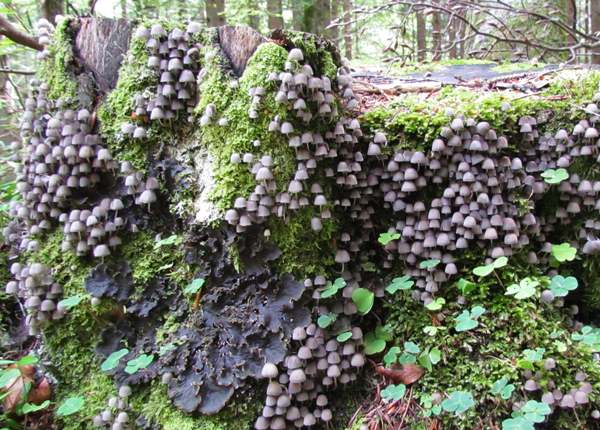
The Fairy Inkcap, Coprinellus disseminatus, rarely ventures forth alone or even with just a few friends; more often it forms dense masses swarming over rotting tree stumps and roots.
These gregarious little fungi occur from early spring until the onset of winter, and they are at their most spectacular when the caps are young and pale - sometimes nearly pure white. It takes just two or three days for young white caps to turn grey and then begin blackening.
Distribution
Common in Britain and Ireland and throughout Europe and North America, the Fairy Inkcap is truly a cosmopolitan mushroom, being found also in most parts of Asia and in South America and Australia. Coprinellus disseminatus usually appears in very large trooping groups on stumps
in woodland and occasionally in shaded hedgerows.
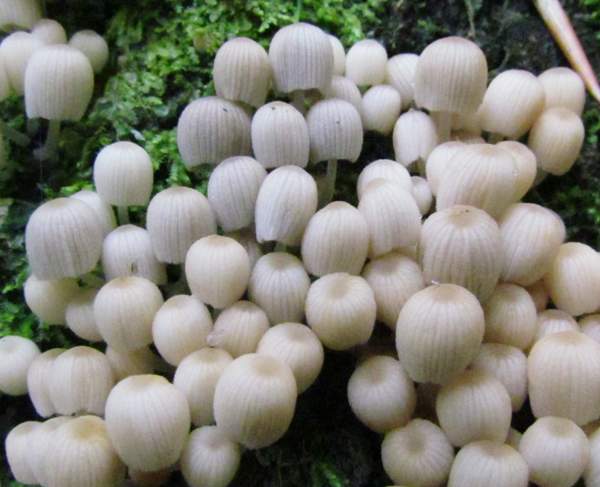
Taxonomic history
Originally described by Christiaan Hendrik Persoon, the Fairy Inkcap was given its present scientific name in 1939 by the Danish mycologist Jakob Emanuel Lange (1864–1941). In many field guides this species is still recorded as Coprinus disseminatus, under which name it was commonly - Classified until 2001.
Synonyms of Coprinellus disseminatus include Agaricus minutulus Schaeff., Agaricus disseminatus Pers., Coprinus disseminatus (Pers.) Gray, Coprinarius disseminatus (Pers.) P. Kumm., and Pseudocoprinus disseminatus (Pers.) Kuhner.
Because it does not autodigest (deliquesce), some authors have placed this species in the genus Pseudocoprinellus rather than in Coprinellus. Hence Pseudocoprinellus disseminatus (Pers.) Kuhner is a synonym.
Other common names for these lovely little mushrooms include Fairies Bonnets (a name likely to cause confusion with Mycena species, which are often referred to as Bonnets or Bonnet Caps) and Trooping Inkcaps.
Common names change with time and location. In America the terms Inky Cap or Inky-cap are most commonly used, while in many older field guides published in Britain you are likely to see Ink Cap or Ink-cap rather than Inkcap.
Another common name given to this species in Trooping Crumble-cap, reflecting their tendency to dinsintegrate when touched; this, with their diminutive stature, is another reason not to try gathering Fairy Inkcaps to take home to cook.
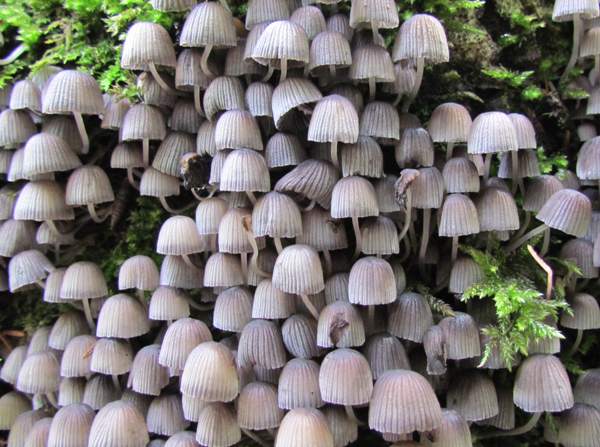
Etymology
The generic name Coprinellus indicates that this mushrooms genus is (or was thought to be) closely related to or at least similar to fungi in the genus Coprinus, which literally means 'living on dung' - that's true of quite a few of the inkcaps but not particularly apt for this and several other Coprinellus species that feed on rotting timber. Coprinellus disseminatus is a vegetarian that does not like 'second hand' food that has already passed through the gut of an animal. The suffix -ellus indicates fungi that produce rather smaller fruitbodies than those of Coprinus species. The specific epithet disseminatus is the past participle of the Latin verb disseminare, formed from the prefix dis-, meaning 'in all directions' (as in display, disintegrate etc) and seminare, meaning 'to plant' or' to propagate' (as in semen, from which is derived the English word seed). Appropriate for these prolific fungal hordes!
The Fairy Inkcaps shown here are the same group that is pictured above but photographed on the following day. The change in cap shape and colour in such a short time is already quite remarkable.
Identification guide
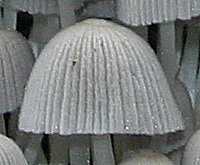 |
Cap
Typically 0.5 to 1.5cm in diameter and
initially 1 to 1.5cm tall, flattening as they open out, the caps of Coprinellus disseminatus are at
first egg-shaped, then bell-shaped often with slightly upturned margins.
Beige when young, the pleated caps turn grey and then blacken
somewhat from the margin. |
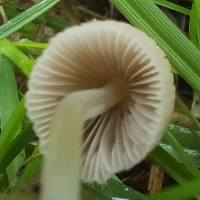 |
Gills
The adnate gills of Coprinellus disseminatus are white, turning grey and
then black as the spores mature. When fully mature they do not dissolve
rapidly into an inky fluid, as many of the ink caps do.
Stem
The thin, hollows stems of the Fairy Inkcap are white and very
fragile. |
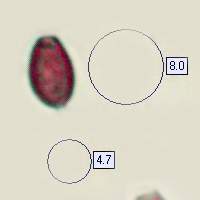 |
Spores
Ellipsoidal to almond-shaped, smooth; 7-9.5 x 4-5µm; with an apical germ pore.
Spore print
Black. |
Odour/taste |
Not distinctive. |
Habitat & Ecological role |
Coprinellus disseminatus is saprobic and occurs on and beside stumps and other forms of rotting wood. |
Season |
August to November in Britain. |
Similar species |
Coprinellus micaceus grows in tufts, but rarely in such
massive groups; it has larger, tan caps which are covered in tiny
glistening veil fragments when young. |
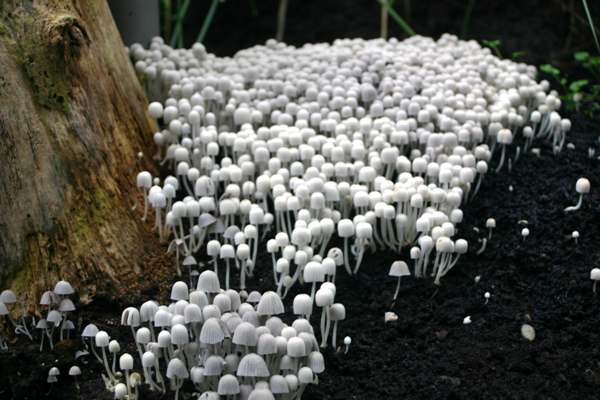
Culinary Notes
The Fairy Inkcap is reported to be edible, but it is insubstantial and not highly regarded.
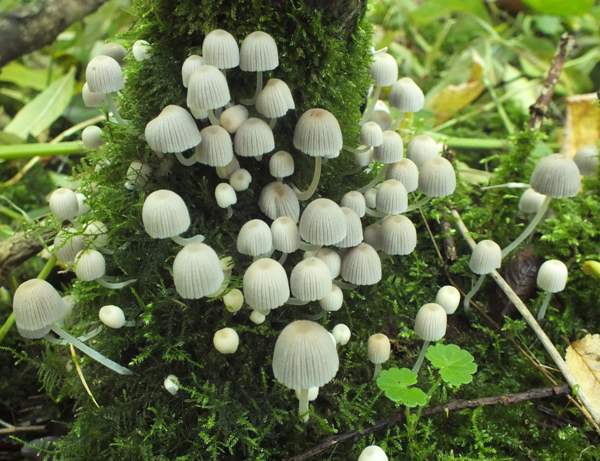
Reference Sources
Fascinated by Fungi, 2nd Edition, Pat O'Reilly 2016, reprinted by Coch-y-bonddu Books in 2022.
Orton, P.D. & Watling, R. (1979). British Fungus Flora: Agarics and Boleti. Vol 2. Coprinaceae: Coprinus. Royal Botanic Garden: Edinburgh.
Redhead SA, Vilgalys R, Moncalvo J-M, Johnson J, Hopple JS Jr.; Vilgalys, Rytas; Moncalvo, Jean-Marc; Johnson, Jacqui; Hopple, Jr. John S (2001). 'Coprinus Pers. and the disposition of Coprinus species sensu lato.'. Taxon (International Association for Plant Taxonomy (IAPT)) 50 (1): 203-41.
English Names for fungi; British Mycological Society, 2013.
Dictionary of the Fungi; Paul M. Kirk, Paul F. Cannon, David W. Minter and J. A. Stalpers; CABI, 2008
Taxonomic history and synonym information on these pages is drawn from many sources but in particular from the British Mycological Society's GB Checklist of Fungi.
Top of page...
Fascinated by Fungi. Back by popular demand, Pat O'Reilly's best-selling 450-page hardback book is available now. The latest second edition was republished with a sparkling new cover design in September 2022 by Coch-y-Bonddu Books. Full details and copies are available from the publisher's online bookshop...